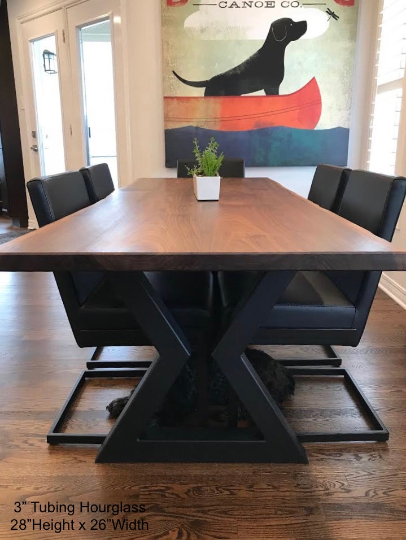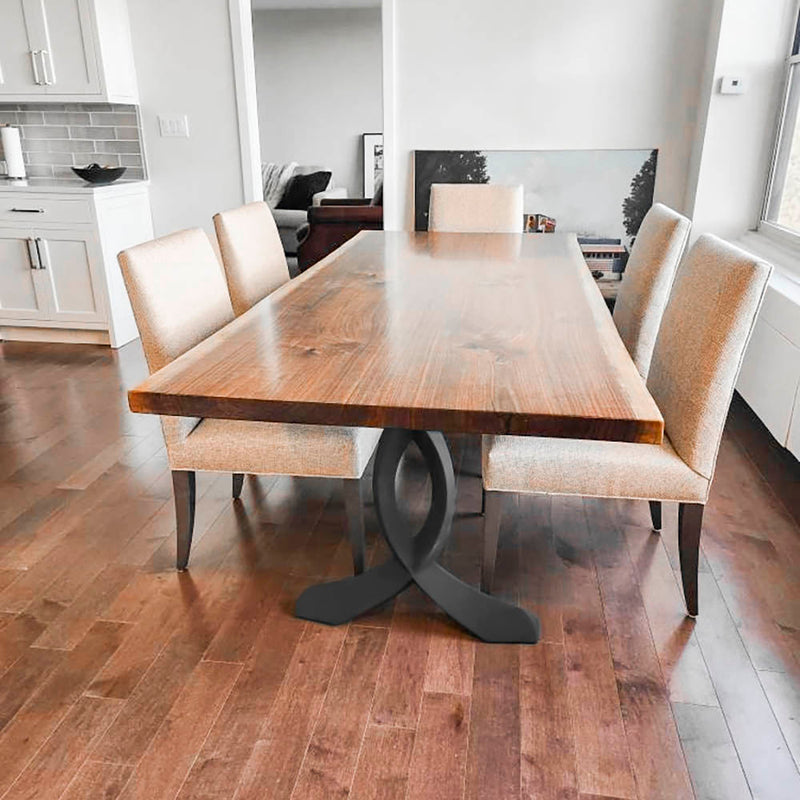Why Dining Room Table Legs Are Crucial for Your Table’s Stability
Wiki Article
From Conventional to Modern: Discover the Ideal Eating Area Table Legs for Your Style
While classic layouts such as cabriole and transformed legs evoke a sense of timeless class, modern designs like hairpin and geometric options present a chance for striking visual rate of interest. As you take into consideration these aspects, the question continues to be: just how can you perfectly integrate these varied leg designs to produce an unified dining experience?Comprehending Table Leg Styles
The variety of eating room table leg styles can dramatically affect both the aesthetic appeals and capability of the area. Each leg design contributes one-of-a-kind functional features and aesthetic components, dealing with diverse layout choices and use needs. Comprehending these designs is vital for choosing the ideal dining table that straightens with your overall interior decoration vision.For example, conical legs provide a clean, traditional appearance that can boost an area's sophistication, while stand bases provide stability and take full advantage of legroom, making them suitable for smaller spaces. Barrette legs, a characteristic of mid-century contemporary design, introduce a commercial flair, permitting for an airy, open feeling. Trestle legs evoke rustic charm, providing durable assistance and a sense of eternity.
Additionally, the selection of products plays a considerable role. Wooden legs can bring heat and texture, whereas steel options frequently share a smooth, contemporary vibe. Eventually, comprehending table leg styles is important for developing a cohesive eating area that reflects personal design while guaranteeing practicality and convenience. By thoughtfully thinking about these components, you can enhance both the practical and visual charm of your eating area.
Standard Table Leg Options
When picking dining-room table legs, standard choices often symbolize timeless style and workmanship. These styles reflect a rich heritage and a commitment to quality, making them ideal for those who appreciate classic aesthetic appeals.One of the most legendary traditional leg styles is the cabriole leg, characterized by its stylish curved shape. This layout usually features decorative makings and is most commonly found in Queen Anne and Chippendale furnishings. An additional popular alternative is the turned leg, which flaunts a series of smooth, rounded shapes that provide a traditional look while maintaining security.
In addition, the straight leg, while basic, supplies a basic and durable framework that can mix perfectly with a selection of tabletop designs. For those attracted to ornate describing, claw-and-ball feet legs evoke a sense of magnificence and can offer as a spectacular focal point in any type of dining area.
Last but not least, pedestal bases, although not strictly legs, supply an alternate typical option that permits sufficient legroom and can be perfectly carved. Each of these traditional leg designs adds to the overall ambiance of a dining-room, marrying feature with visual allure.

Modern Table Leg Designs
Modern table leg styles supply a diverse range of designs that emphasize tidy lines and ingenious products. These styles commonly prioritize capability while working as striking centerpieces within a dining area. Minimalist looks prevail, with legs crafted from products such as metal, glass, and engineered timber, which add to a contemporary and ventilated feel.One prominent layout is the hairpin leg, defined by its slim, tapered framework that provides stability without frustrating the table top (dining room table legs). This style is commonly located in mid-century modern furniture and can easily enhance various dining table forms. An additional trend is making use of geometric forms, where legs may take on angular or unbalanced forms, adding visual passion and a touch of artistry

Mixing Designs for Special Areas
Typically, house owners seek to create distinct dining rooms that mirror their individual style by blending numerous layout aspects. This method enables the incorporation of varied appearances, causing an unified yet distinctive environment. For example, combining a rustic wooden table with sleek, modern-day metal legs can create an attractive comparison that raises the room's total charm.In addition, integrating vintage table legs with modern table tops can evoke a feeling of history while keeping a modern perceptiveness. Such combinations not just showcase specific taste however also motivate creativity, enabling homeowners to curate a room that feels both individual and inviting.
Shade plays a critical function in this mixing procedure; selecting table legs that enhance or contrast with the existing color pattern can boost visual rate of interest. For example, whitewashed legs can soften the boldness of a dark table surface area, creating a balanced visual.
Tips for Selecting the Right Legs
Picking the right table legs is vital for attaining both functionality and visual look here allure in your dining space. Begin by thinking about the total style of your room. Standard setups benefit from legs that feature complex makings or transformed designs, while contemporary areas may call for smooth, minimal designs.Following, assess the height and stability of the legs. dining room table legs. Conventional eating tables range in between 28 to 30 inches in height, so make sure the legs enhance this dimension for convenience. Additionally, robust products, such as wood or steel, can boost security and durability
Examine the leg form too-- alternatives consist of right, tapered, or pedestal layouts. Straight legs offer a classic look, while conical legs can include a touch of elegance. Pedestal bases provide enough legroom and are perfect for smaller spaces.
Conclusion
In summary, choosing the suitable dining-room table legs requires careful consideration of both modern and traditional styles. Conventional choices such as cabriole and turned legs supply timeless sophistication, while contemporary styles like hairpin and geometric shapes offer visit the site a modern touch. By integrating leg design, height, and material with the total décor, a natural and welcoming environment can be achieved. Ultimately, the picked table legs must show the desired visual, improving the dining experience within the click to read more room.The variety of eating room table leg designs can substantially influence both the visual appeals and capability of the area. Ultimately, comprehending table leg styles is crucial for producing a natural dining location that reflects personal design while guaranteeing practicality and convenience.One of the most iconic typical leg styles is the cabriole leg, characterized by its stylish bent shape. Straight legs supply a classic appearance, while conical legs can add a touch of sophistication.In summary, choosing the excellent dining space table legs calls for careful factor to consider of both contemporary and typical styles.
Report this wiki page